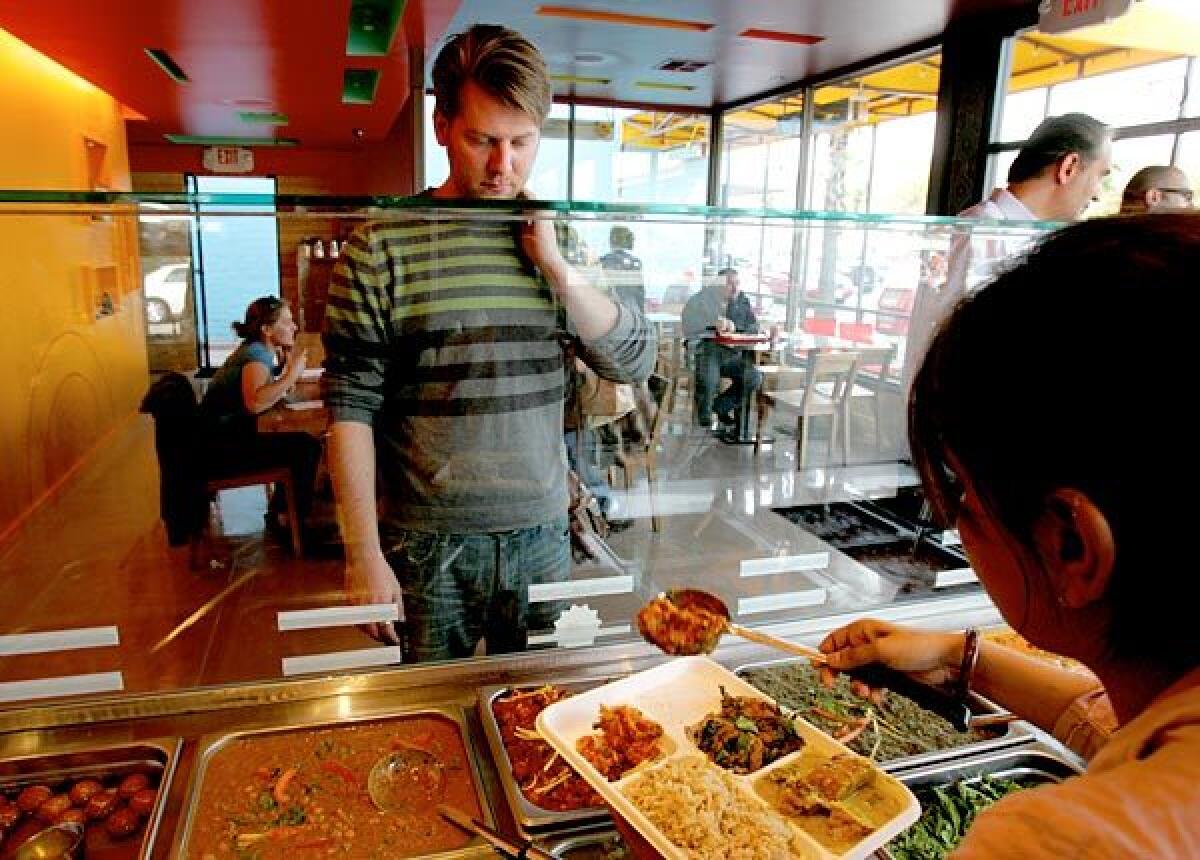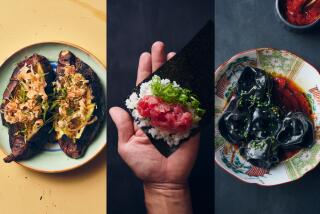Samosa House East in Culver City

This is how to eat an order of pani puri at Samosa House East, home of some of the best Indian snacks in Los Angeles. First, roll up your sleeves. Pani puri is chaat -- Indian street snack food -- and demands to be eaten with the fingers, lustily, and with some degree of abandon.
FOR THE RECORD:
Restaurant review: A Jan. 20 review of the restaurant Samosa House East in Culver City referred to a mint water served with the street snack pani puri as jarijirra. It is jaljira. —
Then get ready to move. Pani puri comes in parts, and it demands a certain degree of focus and speed to assemble. There’s the puri -- half a dozen or so egg-sized, eggshell-delicate balls of crisp, transparent fried bread. And there is the filling: raw onions, raw tomatoes, chickpeas, intensely sauced with mint chutney and tamarind. Finally, and most important, there’s a small cup of jarijirra -- dense green mint water, laced with cumin and fennel.
You place a puri in your palm, and carefully, oh so carefully, break a small hole in the top. Take the utmost care not to breach the bottom of the shell. Slight, quick taps of your forefinger will do. Imagine that you are a tiny woodpecker, gently exploring a bonsai tree. Then spoon in some of the filling through the hole -- gently, or you’ll shatter the shell.
Now, bring the laden shell close to the mint water and, quickly as you can, spoon in as much mint water as the shell will hold. Work fast! From the moment the first bit of mint water goes in, you have about five seconds before the whole thing loses structural integrity and collapses onto your shirt. Throw the whole thing into your mouth and bite.
If you’ve done it right, you’ll be rewarded with one of the most explosive bites on the planet: a shattering of crisp bread, followed by a gush of chilled, crisp, refreshing mint water and then the crunch and chew of raw onions and chickpeas. It’s sort of like a gazpacho hand grenade.
‘It’s fun food!’
Filling and eating a pani puri is a narrative experience, with mounting tension, climax and the clear possibility of wet disaster. “In India, you’re standing on the street, and the seller’s filling and handing puris to you and you keep eating and eating and eating, and he counts how many you ate in the end,” explains Samosa House owner Vibha Bhojak. “It’s fun food!”
The sister restaurants -- the original Samosa House and Samosa House East, which opened in Culver City about a month ago -- are casual places: Order at the steam table, bring your cafeteria tray to your table. A lot of people wander in for takeout. (Culver City recently also has seen the opening of another Indian restaurant, Bawarchi on Venice Boulevard.)
The entire menu is vegetarian, and most of it is vegan. Bhojak first encountered the idea of veganism when she immigrated to the United States; she was deeply impressed. She has modified her cooking methods to match.
Neither Samosa House uses butter or cream. She substitutes ground nuts for cream in her sauces but breaks from veganism for yogurt-based curries and paneer (farmer’s cheese).
Natural flavors
Gone is the lush richness of ghee (Indian clarified butter).
Bhojak largely cooks with olive oil. “Cream kills the flavors of food,” Bhojak says. “Lentil, for example, has its own flavor, and you lose it when you use butter and cream.” The result is curiously reminiscent of, say, Berkeley cooking: quiet spicing; clear, light sauces; and a focus on keeping the natural flavors of vegetables.
The strongest flavor in her squash curry is the deep, warm flavor of fresh squash. Whether this represents a loss of authenticity or the natural evolution of Indian cooking is for you to decide.
The mildest dishes are the soy-based mock fish and mock chicken curries. The wildest dish on the steam table is usually the jackfruit: a meaty, savory dish, full of warm, fermented energy -- Bhojak doesn’t mask the subtle bitterness of jackfruit.
But the best stuff at Samosa House East -- the stuff that challenges the best of Artesia’s Little India -- is from the tiny chaat menu, all fresh-made for textural perfection.
The shining star of Samosa House East is bhel puri -- a great pile of chunky chickpea flakes, puffed rice, raw tomatoes, raw onions, chickpeas and many other little crunchy spiced tidbits. It’s almost a study in variations of crunch: about eight distinct crispy textures, tossed together with vividly tangy, sweet, minty, sour sauce.
It’s the awesome Indian love child of a cold summer salad and Chex snack mix.
For a perfect finish, drive east a few blocks to the original Samosa House, for Bhojak’s gorgeously moist, cheesy, sweet burfi -- like dairy fudge. It’s one of the crown dessert jewels of the Westside. It is, however, not vegan.
More to Read
Eat your way across L.A.
Get our weekly Tasting Notes newsletter for reviews, news and more.
You may occasionally receive promotional content from the Los Angeles Times.










